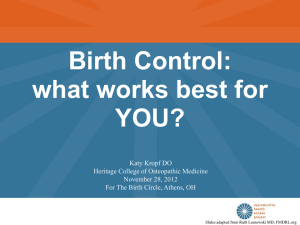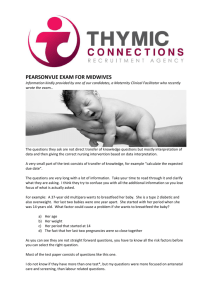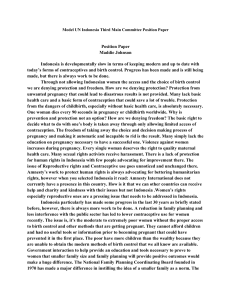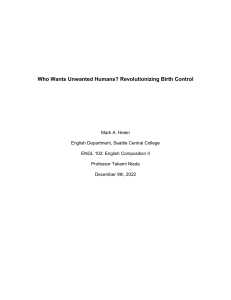Available and Affordable Contraceptives by
advertisement
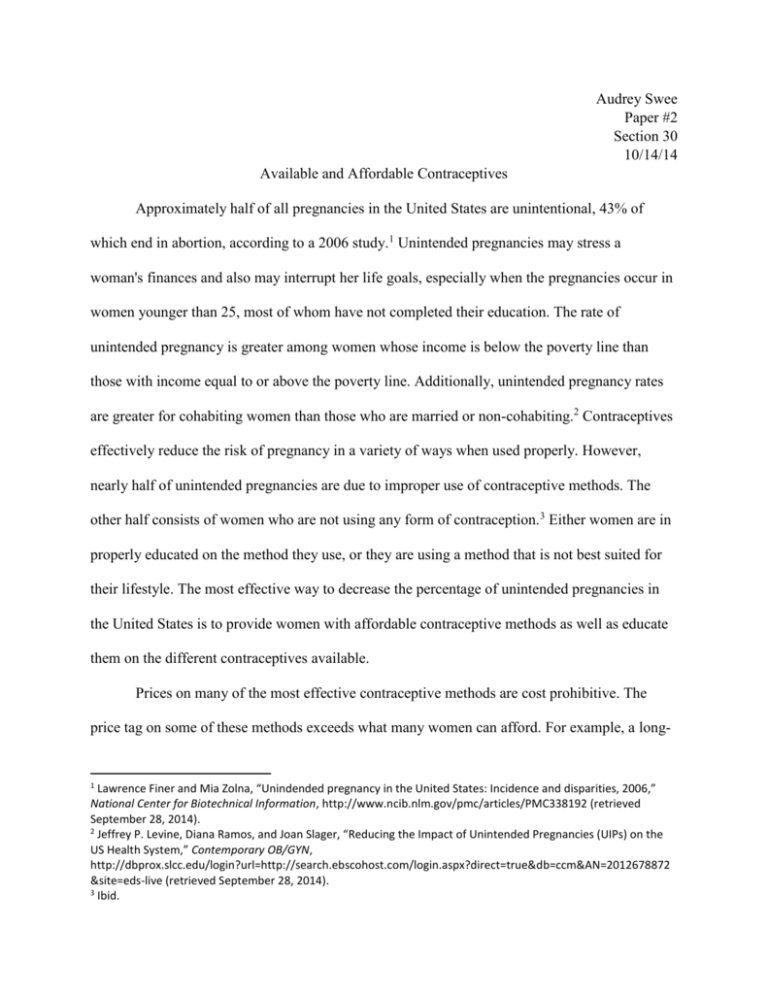
Audrey Swee Paper #2 Section 30 10/14/14 Available and Affordable Contraceptives Approximately half of all pregnancies in the United States are unintentional, 43% of which end in abortion, according to a 2006 study.1 Unintended pregnancies may stress a woman's finances and also may interrupt her life goals, especially when the pregnancies occur in women younger than 25, most of whom have not completed their education. The rate of unintended pregnancy is greater among women whose income is below the poverty line than those with income equal to or above the poverty line. Additionally, unintended pregnancy rates are greater for cohabiting women than those who are married or non-cohabiting.2 Contraceptives effectively reduce the risk of pregnancy in a variety of ways when used properly. However, nearly half of unintended pregnancies are due to improper use of contraceptive methods. The other half consists of women who are not using any form of contraception.3 Either women are in properly educated on the method they use, or they are using a method that is not best suited for their lifestyle. The most effective way to decrease the percentage of unintended pregnancies in the United States is to provide women with affordable contraceptive methods as well as educate them on the different contraceptives available. Prices on many of the most effective contraceptive methods are cost prohibitive. The price tag on some of these methods exceeds what many women can afford. For example, a long- 1 Lawrence Finer and Mia Zolna, “Unindended pregnancy in the United States: Incidence and disparities, 2006,” National Center for Biotechnical Information, http://www.ncib.nlm.gov/pmc/articles/PMC338192 (retrieved September 28, 2014). 2 Jeffrey P. Levine, Diana Ramos, and Joan Slager, “Reducing the Impact of Unintended Pregnancies (UIPs) on the US Health System,” Contemporary OB/GYN, http://dbprox.slcc.edu/login?url=http://search.ebscohost.com/login.aspx?direct=true&db=ccm&AN=2012678872 &site=eds-live (retrieved September 28, 2014). 3 Ibid. 2 active reversible contraceptive method (LARC) with one of the lowest rates of unintended pregnancy as typically used outside of medical experiments is the Intrauterine Device (IUD), which can cost between $500 and $1000.4 Since women who earn very little are at higher risk of unintended pregnancy, healthcare providers and insurance companies must make effective birth control affordable in an attempt to reduce the risk of unintended pregnancy in this targeted population. The Contraceptive Choice Project in St. Louis, Missouri, recognizes this issue and has taken the next step. Funded by the Susan Thompson Buffett Foundation, this cohort study provides a large sum of women with their choice method of contraception at no cost, targeting women who are at high risk (poor, young, highly sexually active, and/or black).5 Seventy-five percent of these participants chose a LARC method, which proved to be the most satisfying method of contraception when compared to the satisfaction of those who chose non-LARC methods.6 The Choice Project demonstrates that at-risk women desire to control their fertility and show interest when presented with affordable or free methods of contraception. The study also shows that long-term, highly effective methods are the most satisfying. If women had access to and education about these satisfying methods, it is more likely that women will choose them. The Choice Project is successfully designed to help women on a local level. Nationally, the Patient Protection and Affordable Care Act (PPACA), though controversial in terms of religious freedom, is a federal policy to make insurance affordable and also to enforce that health insurance providers cover contraceptive methods.7 According to 4 Planned Parenthood Federation of America Inc., “Birth Control,” Planned Parenthood, http://www.plannedparenthool.org/health-info/birth-control (retrieved September 28, 2014). 5 Janine Spain, et al, “The Contraceptive CHOICE Project: recruiting women at highest risk for unintended pregnancy and sexually transmitted infection,” National Center for Biotechnical Information, http://www.ncib.nlm.nih.gov/pubmed/20831439 (retrieved September 28, 2014). 6 The Contraceptive Choice Project, Washington University School of Medicine, http://www.choiceproject.wustl.edu/ (retrieved September 28, 2014). 7 Peter West-Oram, “Freedom of Conscience and Health Care in the Unites States of America: The Conflict Between Public Health and Religious Liberty in the Patient Protectionand Affordable Care Act,” Health Care Analysis 21.3 3 regulations as mandated by the PPACA, the Department of Health and Human Services (DHHS) is required "to adopt a list of preventative services for women ... That must also be covered without cost sharing. in August 2011 DHHS Announced that these would include all FDAapproved contraceptives, counseling about domestic violence and STI's, and screening for [HPV], HIV, and gestational diabetes."8 Under these guidelines women across the nation with many insurance policies now have access to free, FDA-approved contraceptives. A huge concern for government officials is the $11 billion of United States taxpayer money that covers unplanned births.9 By offering free birth control nationwide, the cost to care for children from unintended pregnancies should decline, allowing these funds to be better allocated. The PPACA has a huge influence on decreasing the number of unintended pregnancies. Informing women on the different methods of birth control is one important step in the right direction for preventing unintended pregnancy. Women need to know which options of birth control are available to them in order to choose which method best suits their behavior. Abstinence is the only absolute practice to control pregnancy: if sperm have no access to an ovum, a woman cannot become pregnant. Because it is free and 100% successful, abstinence is the most desirable method to end unintended pregnancies. However urging women to refrain from engaging in sexual activity is hopeless, and despite enforcement, women will not remain abstinent. This is why birth control is crucial to preventing unintended pregnancies. For women who have no difficulty in keeping a strict routine, the birth control pill is appropriate. With (2013): 237-247, http://dbprox.slcc.edu/login?url=http://search.ebscohost.com/login.aspx?direct=true&db=ccm&AN=2012214401 &site=eds-live (accessed September 28, 2014). 8 Debra Stulberg, “The Patient Protection and Affordable Care Act and Reproductive Health: harnessing Date to Improve Care,” Journal of Health Politics, Policy & Law 38.2 (April 2013):441-456, http://dbprox.slcc.edu/login?url=http://search.ebscohost.com/login.aspx?direct=true&db=ccm&AN=2012060340 &site=eds-live (retrieved September 29, 2014). 9 The Contraceptive Choice Project. 4 perfect use, which means taking the pill at the save time daily, the failure rate is less than 1%. When used improperly and inconsistently, the failure rate is around 9%.10 Women who are not as rigid in routine will have better success with an implant, when the failure rate (less than 1%) cannot be affected based on lifestyle, because the one-time implant can last up to three years.11 The best option for women not planning to have children for many years is an IUD which can last up to seven or twelve years, depending on which type. Finally, a women who never desires to have children or is finished having children can have tubal sterilization, commonly known as having her “tubes tied.” This is meant to be a permanent procedure to prevent any future pregnancies.12 There are many other methods that women may choose from depending on their desires. Knowing her options, a woman can make the decision herself to know which is best for her. There are health concerns for some women with certain contraceptives, which further supports why women should understand their options and which method is best for them. One of the more prevalent concerns that women have is weight gain, which can occur with many hormonal birth control methods. Many contraceptives do not involve hormonal changes, including condoms, birth control sponges, cervical caps, and more. These generally have higher failure rates than hormonal birth controls, but they are much better than the alternative—not using any birth control method, which has a failure rate of 85%.13 Another concern is the change that some contraceptives have on the body. Some can affect the vaginal microbial flora of women who suffer from infections that disrupt the existing bacterial environment, like urinary tract infections. However, research suggests that women prone to these sorts of infections may 10 Planned Parenthood Federation of America Inc., “Birth Control.” Ibid. 12 Ibid. 13 Schiffert Health Center, “Contraceptive Methods: Failure Rates,” Health Center, 11 5 choose the birth control pills over the cervical cap or diaphragm spermicide. The pills have a less significant effect on the vaginal microbial flora than the other two methods. Because there are so many contraceptive options, there is no reason for women at high risk of unintended pregnancy not to choose one method or another. When women are informed about the different types of contraceptives available, they can appropriately choose a method that is right for them. Whether women are worried about expensive or chemically undesirable contraceptives, there is an option. Whether they are worried about reversible or irreversible methods, they have a choice. If they are worried about lifestyle changes, they have a variety of options to fit their specific needs. Once women know their options and are educated on the manner of use and effectiveness of every option, then women are more likely to choose an appropriate method for their lifestyle. Women need the option to be in control of their fertility. When they can’t afford contraceptive methods, something must be done to make these methods available to them. The Choice Project and health insurance providers under the PPACA are providing for women free methods of contraception. When women are educated and provided with affordable forms of birth control, the amount of unplanned pregnancies with shrink. Then this is accomplished, women will likely have more success in attaining their life goals.


